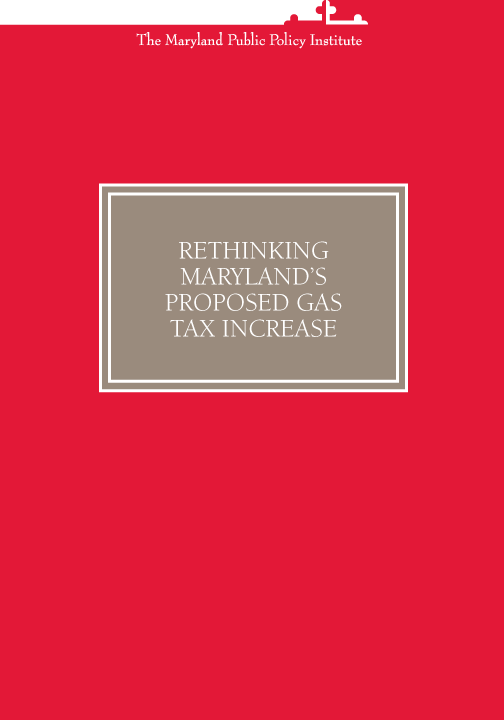
Rethinking Maryland's Proposed Gas Tax Increase
In late 2011 the Blue Ribbon Commission on Maryland Transportation Funding issued its report, and recommended that the state fuel tax be increased by a total of 15 cents per gallon in three years' time, and indexed for inflation thereafter; that registration fees be increased 50 percent; and that the titling tax be increased to 6.5 percent. All of these changes are estimated to bring in an additional $810 million per year when fully implemented. In turn, these additional funds are proposed to be spent on transportation projects in the state.
Since the report was issued, several business groups, legislators, and the governor have either endorsed the plan, or have indicated they may favor an increase in the state's fuel tax, to increase transportation spending to create jobs, relieve congestion, and improve the quality of the infrastructure.
Other business groups and a number of state legislators of both parties are skeptical of these costly proposals and oppose the tax increases. They note that in the past, Maryland has diverted large sums of transportation funds to non-transportation purposes. This report identifies the misallocation of more than half the state's transportation funds that is spent on transit - which serves fewer than 10 percent of commuters at heavy costs and worsening the state's traffic congestion. It further notes that without a sensible investment plan and meaningful goals, these new funds are likely to be as poorly utilized as those in the past.
This report also focuses on the distributional inequities that a fuel tax, and a fuel tax increase, induce among households of different income levels. Although it is widely understood that a gas tax is regressive in the sense that lower-income households pay a greater share of their income on the tax than do higher-income households, this report attempts to better quantify - using data derived from a study recently published by the Transportation Research Board - just how regressive the Maryland fuel tax is - at current levels, and would be if the increases that the Commission has recently proposed are enacted into law.
Specifically, this report estimates that after the proposed tax increase, the lowest-income brackets would pay a share of their incomes more than seven times greater than the share paid by the wealthier households. As a result, the lower-income households likely will choose to decrease their driving to a much greater extent than would higher- income households, an outcome that has important implications for job access at a time when gas prices are also very high.
Finally, this report describes a number of non-tax approaches that several states have adopted to increase infrastructure funds without increasing taxes. These include performance and financial audits of the state's transportation programs, and the use of public-private partnerships to encourage private sector investment in infrastructure. At present, Virginia is in the process of raising about $5 billion in non-tax resources to fund major transportation infrastructure projects throughout the state.
Executive Summary
In late 2011 the Blue Ribbon Commission on Maryland Transportation Funding issued its report, and recommended that the state fuel tax be increased by a total of 15 cents per gallon in three years' time, and indexed for inflation thereafter; that registration fees be increased 50 percent; and that the titling tax be increased to 6.5 percent. All of these changes are estimated to bring in an additional $810 million per year when fully implemented. In turn, these additional funds are proposed to be spent on transportation projects in the state.
Since the report was issued, several business groups, legislators, and the governor have either endorsed the plan, or have indicated they may favor an increase in the state's fuel tax, to increase transportation spending to create jobs, relieve congestion, and improve the quality of the infrastructure.
Other business groups and a number of state legislators of both parties are skeptical of these costly proposals and oppose the tax increases. They note that in the past, Maryland has diverted large sums of transportation funds to non-transportation purposes. This report identifies the misallocation of more than half the state's transportation funds that is spent on transit - which serves fewer than 10 percent of commuters at heavy costs and worsening the state's traffic congestion. It further notes that without a sensible investment plan and meaningful goals, these new funds are likely to be as poorly utilized as those in the past.
This report also focuses on the distributional inequities that a fuel tax, and a fuel tax increase, induce among households of different income levels. Although it is widely understood that a gas tax is regressive in the sense that lower-income households pay a greater share of their income on the tax than do higher-income households, this report attempts to better quantify - using data derived from a study recently published by the Transportation Research Board - just how regressive the Maryland fuel tax is - at current levels, and would be if the increases that the Commission has recently proposed are enacted into law.
Specifically, this report estimates that after the proposed tax increase, the lowest-income brackets would pay a share of their incomes more than seven times greater than the share paid by the wealthier households. As a result, the lower-income households likely will choose to decrease their driving to a much greater extent than would higher- income households, an outcome that has important implications for job access at a time when gas prices are also very high.
Finally, this report describes a number of non-tax approaches that several states have adopted to increase infrastructure funds without increasing taxes. These include performance and financial audits of the state's transportation programs, and the use of public-private partnerships to encourage private sector investment in infrastructure. At present, Virginia is in the process of raising about $5 billion in non-tax resources to fund major transportation infrastructure projects throughout the state.





